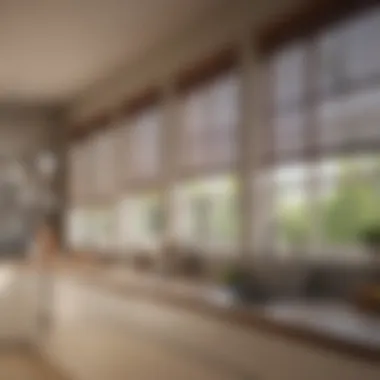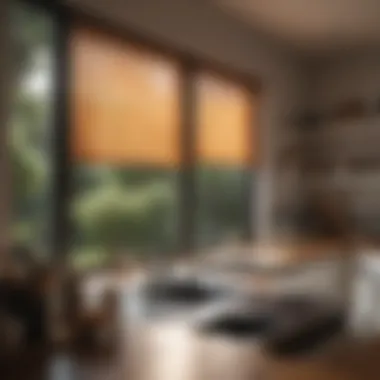Expert Tips for Cleaning Kitchen Blinds Effectively


Intro
Cleaning kitchen blinds might seem a small task, yet it holds significance in maintaining the overall aesthetic of the space. This guide will delve into the different types of kitchen blinds, effective cleaning techniques, and essential maintenance tips. Homeowners often overlook the accumulated dust and grime on blinds, which can impact both cleanliness and the longevity of these fixtures. By understanding how to care for them properly, one can enhance not only the visual appeal of their kitchen but also the indoor air quality.
Though perhaps the least glamorous aspect of home care, keeping blinds clean ought to be a component of any diligent cleaning routine. The methods utilized can vary based on the materials and designs at play. In this guide, we will explore specifics, ensuring you have the knowledge needed to tackle any blind type with ease.
Featured Homes
Understanding how kitchen blinds fit into the broader context of home aesthetics provides a foundation for their maintenance. Many featured homes boast designs that cleverly incorporate various blind styles, showcasing their functionality and artistic flair. Whether in modern designs or more traditional homes, kitchen blinds serve as both decorative elements and practical solutions.
Architectural Highlights
Modern features often include large windows and open concepts that can enhance the natural light flowing through a kitchen. This design approach emphasizes the necessity of blinds that blend seamlessly with decor while still providing the necessary privacy. Popular materials include wood, faux wood, and aluminum, each offering unique cleaning challenges and benefits. The choice of type greatly influences how a homeowner should approach the cleaning process.
Interior Design Themes
Blinds should complement the overall aesthetic theme of a kitchen. For example, in a contemporary space, sleek aluminum or minimalist roller blinds often prevail. These clean lines may require less frequent deep cleaning but benefit from a regular dusting. Meanwhile, in a rustic kitchen, wooden blinds can add warmth but may need specific cleaning strategies to avoid damage to the finish. Understanding the relationship between design and maintenance can thus lead to better cleaning choices.
Effective Cleaning Techniques
When tackling the cleaning of kitchen blinds, it’s essential to have the right tools and methods in hand. Here are some effective techniques:
- Dusting: Regular dusting with a microfiber cloth can prevent build-up. This should be done at least weekly.
- Vacuuming: Use a vacuum cleaner with a brush attachment for deeper cleaning about every month.
- Washing: Depending on the material, some blinds can be washed in a bath of warm water mixed with mild detergent.
- Spot Cleaning: For stains, a damp cloth with a gentle cleaner can often suffice. Always follow with a dry cloth to avoid water marks.
To maintain optimal aesthetic and hygiene, cleaning your kitchen blinds should form part of a comprehensive home care routine.
Foreword to Kitchen Blinds
Kitchen blinds serve a fundamental role in maintaining both the aesthetics and functionality of a kitchen space. They provide privacy while allowing natural light to filter through. Understanding kitchen blinds, including purpose and types, is essential for any homeowner. Such knowledge empowers you to choose the correct style that fits your needs.
Purpose of Kitchen Blinds
The primary purpose of kitchen blinds is to control light and privacy. Kitchens are often places of both cooking and social interaction, making it necessary to have an adjustable window covering. By using blinds, you can easily manage sunlight that can affect visibility during food preparation. Moreover, they can help reduce glare on screens and countertops.
Blinds also add an essential touch to the overall decor. They can harmonize with the kitchen theme, enhancing its design flair. Additionally, kitchen blinds protect interiors from UV rays, which can fade curtains or paint over time, ensuring the longevity of your kitchen's aesthetics.
Common Types of Kitchen Blinds
Utilizing the right kind of kitchen blinds is important. Each type has unique characteristics, advantages, or disadvantages.
Vertical Blinds
Vertical blinds are often chosen for their versatility and ease of use. They consist of vertical slats that can be tilted to adjust light levels. A significant characteristic of vertical blinds is the ability to cover large windows or sliding doors efficiently. This makes them a popular option in many modern kitchens.
One unique feature of vertical blinds is their capacity to disperse light evenly. This diffused light can enhance the kitchen ambiance. However, they require regular cleaning to prevent dust buildup along the slats, which can be challenging.
Venetian Blinds
Venetian blinds offer a classic, timeless look that aligns with various kitchen styles. Made of horizontal slats, they allow for precise control over light and privacy. Their key characteristic lies in the tiltable slats that give flexibility in light management.
The unique feature of Venetian blinds is their diverse material options, ranging from wood to aluminum. This variety allows personalization according to taste preferences. However, they can be less effective in covering larger windows compared to vertical blinds, which may limit their use in spacious kitchens.
Roller Blinds


Roller blinds are known for their simplicity and streamlined appearance. They consist of a single piece of fabric that can be raised or lowered as needed. The significant characteristic of roller blinds is their minimalist design. This makes them an excellent choice for contemporary kitchens with a clean aesthetic.
A unique advantage of roller blinds is the availability of numerous fabric designs, giving room to express personal style. However, they may not provide as much light control compared to slatted options.
Cellular Shades
Cellular shades are distinguished by their honeycomb structure, which offers excellent insulation. Their primary purpose is energy efficiency, helping to regulate kitchen temperature. A key characteristic of cellular shades is their ability to trap air, improving the overall energy performance of a home.
The unique feature of these shades is their variety of light filtering options, from sheer to blackout. This adaptability can be particularly useful in kitchens. Their disadvantage lies in the more complex cleaning requirements due to their structure, which can collect dust more readily than flat blinds.
The Importance of Cleaning Kitchen Blinds
Cleaning kitchen blinds goes beyond mere aesthetics. It plays a crucial role in maintaining a healthy living environment and enhancing the overall appearance of your kitchen. Over time, blinds can accumulate dust, allergens, and dirt, which can negatively influence indoor air quality and visual appeal. Understanding the importance of this regular cleaning task can help homeowners ensure that their kitchen remains a tidy and welcoming space. This article will explore two vital aspects: health implications and aesthetic benefits, underscoring the need for consistent maintenance of these oft-overlooked fixtures.
Health Implications
Allergen Accumulation
Allergen accumulation in kitchen blinds can be a significant concern for many households. Dust mites, pollen, and pet dander often settle on surfaces, including blinds. These allergens can trigger respiratory issues and other allergic reactions. Regular cleaning not only helps to minimize these health risks but also contributes to a more pleasant living environment.
The key characteristic of allergens is their invisible nature; they can be easily overlooked until they cause discomfort. Therefore, understanding this concept is essential. These allergens can quickly build up if blinds are neglected, making it harder to breathe, especially for individuals with allergies or asthma. Thus, addressing allergen accumulation directly relates to the overall goal of maintaining good health in your home.
Dust and Dirt Buildup
Dust and dirt buildup is another major reason why cleaning kitchen blinds is important. Over time, a layer of grime can accumulate, dulling the appearance of your blinds and negatively affecting the kitchen’s ambiance. Regular cleaning removes this buildup and keeps your blinds looking fresh. Dust is not just unsightly; it can also lead to more complex maintenance issues in the long run.
One key aspect of dust and dirt is that it can serve as a breeding ground for bacteria and other pathogens. This makes it imperative to implement regular cleaning practices. The unique feature of addressing such buildups through cleaning is the immediate improvement you can achieve. As a result, your kitchen feels fresher and more inviting, enhancing your cooking and dining experience.
Aesthetic Benefits
Enhancing Room Appearance
One of the most noticeable benefits of cleaning kitchen blinds is their contribution to the overall appearance of a room. Clean blinds can significantly improve the aesthetic appeal of your kitchen. When dust and stains are cleared away, the blinds can reflect light better and complement your kitchen decor seamlessly.
The key characteristic here is clarity; clean blinds allow light to pass through unobstructed, brightening the entire room. Enhancing the room's appearance through regular maintenance of your blinds is a simple yet effective way to elevate the overall look of the space. This, in turn, can make a kitchen feel more modern and well-kept, appealing to both homeowners and guests.
Reflecting Light Properly
The proper reflection of light is crucial for creating a warm and inviting ambiance. Kitchen blinds that are regularly cleaned can effectively control natural light, allowing for a more versatile space. Depending on your preferences, you can manage how much light enters your kitchen at different times of the day.
The unique feature of well-maintained blinds is their ability to work in harmony with other light sources in your kitchen. They can enhance natural illumination, leading to a more functional workspace. In this way, reflecting light properly not only improves the aesthetic but also boosts the usability of your kitchen. It’s vital to consider these aspects of kitchen blinds' performance when engaged in cleaning and maintenance routines.
"Regular maintenance of kitchen blinds is not merely a chore; it is an investment in your home's health and appeal."
In summary, the importance of cleaning kitchen blinds should not be underestimated. Through addressing health implications and aesthetic benefits, homeowners can enjoy a cleaner, healthier, and more visually pleasing kitchen environment.
Tools and Supplies Needed for Cleaning
Cleaning kitchen blinds requires the right tools and supplies. The effectiveness of your cleaning efforts largely depends on these choices. Each type of blind may need specific tools to clean effectively. Having the proper tools not only ensures cleaner blinds but also saves time and effort. You will avoid potential damage that can occur with subpar equipment. Therefore, understanding what you need is crucial for both maintaining the aesthetic appeal and extending the lifespan of your kitchen blinds.
General Cleaning Tools
When it comes to general cleaning tools, a few essential items are necessary to start the cleaning process effectively. These tools include dusters, sponges, and buckets, which help in removing dust and grime from various types of blinds. A microfiber cloth is paramount among these tools. It helps to trap dirt without scratching surfaces, thus preserving the condition of your blinds.
You can also consider using rubber gloves to protect your hands from harsh cleaning solutions or dust, depending on the condition of the blinds. When choosing tools, select those that are designed for delicate cleaning tasks. This is especially important for intricate designs or delicate materials.


Specific Supplies for Different Blinds
Different blinds may require specialized cleaning supplies to ensure effective cleaning without damage. Knowing which supplies fit each kind of blind makes the cleaning process more efficient and productive.
Microfiber Cloths
Microfiber cloths are essential for cleaning kitchen blinds. Their unique weave allows for superior dirt and dust trapping. This is why they are a popular choice. Microfiber is soft and non-abrasive, making it ideal for delicate surfaces, preventing scratches or wear. Additionally, these cloths can usually be cleaned and reused, which is an economical benefit.
Their absorbent quality allows for effective damp cleaning without lint residue. However, it is essential to wash them properly after use, as built-up grime can hinder their performance.
Vacuum Cleaner Attachments
Vacuum cleaner attachments greatly enhance cleaning effectiveness. Many vacuums come with specific attachments designed for cleaning narrow spaces and delicate surfaces, which are perfect for blinds. The primary feature is their ability to remove dust without having to manually wipe surfaces. This minimizes the risk of damaging the blinds with excessive physical contact.
However, one must be cautious when using these attachments because strong suction can sometimes dislodge or damage delicate components. It is important to use the right settings for cleaning blinds to ensure gentle yet effective dust removal.
Specialized Blind Cleaners
Specialized blind cleaners are formulated to tackle built-up grime and stubborn stains that ordinary cleaning products might not remove. These cleaners often come in spray form, which allows for easy application. They are particularly beneficial for materials like faux wood or aluminum.
The key characteristic of these cleaners is their ability to break down residues without harming the finish of the blinds. However, they can have chemical components that may not be suitable for all materials, so checking compatibility is essential. Consider the specific type of blinds and their material before applying any specialized cleaner.
Step-by-Step Guide to Cleaning Kitchen Blinds
Cleaning kitchen blinds is not just a mundane task; it is vital in maintaining the overall aesthetics and hygiene of your kitchen. Dust, grime, and allergens can build up, impacting the quality of air in your home and making your space look unkempt. By engaging in a structured cleaning process, you can extend the lifespan of your blinds and improve the ambiance of your kitchen. The following subsections provide a clear roadmap to effectively clean various types of kitchen blinds.
Preparing the Area
Before initiating the cleaning process, it is crucial to prepare your workspace. Start by removing any obstacles around the blinds, making sure appliances and furniture are safely moved away. This not only allows easy access to the blinds but also prevents accidental damage during cleaning. Lay down a drop cloth or towel below the blinds to catch any running dirt or debris. Additionally, wear gloves to protect your hands from potential irritants in cleaning solutions.
Dusting Off the Blinds
Dusting is the initial step that should not be overlooked. Use a microfiber cloth or a duster to gently wipe each slat, moving from top to bottom. This method ensures that the dirt falls away instead of redistributing it. For hard-to-reach spots, an old sock can be used for effective dusting. If your blinds are particularly dusty, consider using a vacuum cleaner with an appropriate attachment to remove stubborn particles.
Deep Cleaning Process
Once dusting is complete, a deeper clean is necessary for a thorough cleanse. There are two primary methods to achieve this: using water and soap, and specialized cleaning solutions.
Cleaning with Water and Soap
Cleaning with water and soap is a straightforward approach that is often effective and safe for most blind materials. Use a mixture of warm water and a few drops of dish soap. This basic solution helps break down grease and dirt without harsh chemicals.
The key characteristic of this method is its simplicity. It is a widely recommended choice due to its efficacy and accessibility, as most households have soap on hand.
You can effectively use a soft cloth or sponge soaked in the soap solution to wipe each slat. After cleaning, go over the slats again with plain water to remove any soap residue.
However, one disadvantage is that excess moisture can damage some materials, particularly wood. Therefore, it is essential to wring out the cloth properly before applying to the blinds.
Using Cleaning Solutions for Stains
For tougher stains that water and soap may not suffice, employing specialized cleaning solutions can be beneficial. These products, often available in stores, are formulated to target specific types of grime and stains, including grease and mildew.
A significant advantage of using these solutions is their potency. They can save time and effort when dealing with more stubborn messes. Many options come in spray bottles, allowing for easy application.


However, it is essential to read the labels carefully. Some cleaning solutions may not be suitable for all blind materials and could lead to discoloration or damage. Testing a small, inconspicuous section before full application is always wise to avoid potential issues.
Drying and Maintenance
Once cleaning is complete, give your blinds adequate time to dry before closing or adjusting them. Use a dry cloth to wipe off any remaining moisture. Position the blinds in the open position while they air dry to prevent water stains or mildew. For ongoing maintenance, regular dusting is recommended; a weekly wipe down can greatly reduce build-up and the need for deep cleaning.
Incorporating these steps into a routine cleaning regimen will help maintain the appearance and functionality of your kitchen blinds for years to come.
Maintenance Tips for Kitchen Blinds
Maintaining kitchen blinds is essential for both appearance and functionality. Over time, blinds can accumulate dirt, dust, and even allergens, which may lead to the need for more extensive cleaning efforts than anticipated. Regular maintenance helps mitigate these issues, ensuring that your kitchen blinds remain aesthetic and functional.
A consistent cleaning regime not only extends the life of the blinds but also preserves the overall look of your kitchen. Neglect can lead to permanent stains and damage that may require replacement, which is often more costly than simple maintenance. Thus, establishing and practicing maintenance tips should be regarded as a proactive approach
to keeping kitchen blinds in good shape.
Regular Cleaning Schedule
Creating a regular cleaning schedule is vital for maintaining kitchen blinds. Depending on the type of blinds you have, their exposure to moisture, and how often you use the kitchen, the frequency may vary. For instance, Venetian blinds might require monthly attention, while cellualr shades may only need cleaning every season.
It's beneficial to set reminders in your calendar so that cleaning becomes a part of your routine. This prevents buildup of allergens and grunge that can be harder to remove over time. Regular cleaning ease the process, requiring less effort and fewer supplies to keep your kitchen blinds in appeal.
Preventive Care Strategies
Implementing preventive care strategies is equally significant. These approaches can help avoid major cleaning efforts down the line. Below are two specific strategies:
Using Protective Coatings
Applying protective coatings can be a game changer for your blinds. These coatings create a barrier against dirt, moisture, and stains. They can be especially effective on wood and fabric blinds, ensuring that the material remains intact despite exposure to elements.
A key characteristic of using protective coatings is how they reduce the need for aggressive cleaning methods. Instead of scrubbing, you may simply wipe down the surface. This approach minimizes wear on the blinds, keeping them vibrant longer. However, it’s important to choose a coating that is appropriate for your specific blind material and to reapply as instructed.
Avoiding Excessive Moisture
Moisture can be a significant adversary to kitchen blinds, especially in areas where steam and spills are frequent. Maintaining a dry environment around the blinds helps preserve their lifespan.
A critical aspect of avoiding excessive moisture is proper ventilation in your kitchen. Ensuring that your kitchen has fans or windows that can be opened helps in keeping the area dry. If your blinds are frequently exposed to moisture, they may warp or become damaged, necessitating replacements. By minimizing moisture, you keep your blinds looking fresh and functional longer.
Finale
Cleaning kitchen blinds is not merely a chore; it is an essential aspect of maintaining a healthy and aesthetically pleasing home. The importance of this task extends beyond mere appearance. Regular cleaning helps prevent the accumulation of allergens and dust, which can significantly improve air quality, especially in spaces such as kitchens where food is prepared.
Furthermore, a clean blind reflects light in a more effective manner, enhancing the overall ambiance of the room. Understanding this gives the task of cleaning a deeper sense of significance. When readers grasp this, they may feel more inclined to take the necessary steps to keep their environment tidy and welcoming.
Recap of Cleaning Importance
To summarize, the cleaning of kitchen blinds serves multiple purposes:
- Health Benefits: Removing allergens and dust reduces health risks for residents.
- Visual Appeal: Clean blinds help in reflecting light correctly, thereby enhancing the room’s aesthetic.
- Longevity: Regular maintenance increases the lifespan of the blinds, saving costs in the long run.
Each aspect ties back to the central theme of creating a healthier home environment.
Encouragement for Continued Maintenance
Continued maintenance of kitchen blinds should be regarded as an ongoing commitment rather than a one-time task. Establishing a regular cleaning schedule can create a routine that becomes integrated into daily life.
Here are some practical suggestions to aid in this endeavor:
- Set reminders to clean blinds at regular intervals, such as every three months.
- Inspect blinds regularly for any stains or buildup that may require immediate attention.
- Educate household members on the importance of keeping the blinds clean to foster a collective responsibility.
By prioritizing continued care, homeowners not only invest in the longevity of their blinds but also contribute to their overall living environment. This results in a home that is not only more attractive but also significantly healthier.







